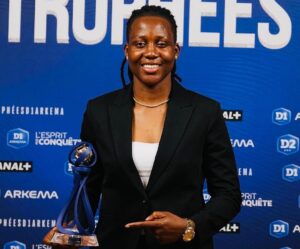
Futoshi Ikeda’s side have already stunned Spain and knocked out Norway in New Zealand. How far can they go?
“The strongest team I have ever seen.” That’s how Caroline Graham Hansen, a two-time Champions League winner with Barcelona, described Japan after the Nadeshiko had beaten her and her Norway team-mates in the last 16 of the 2023 Women’s World Cup. Coming from a world-class footballer who has played at the highest level for many, many years, it’s quite the compliment.
Indeed, as we move into the quarter-finals of the tournament, it’s Japan that are the team to beat. Despite winning the title in 2011 and reaching the final four years later, they didn’t fly to New Zealand with high expectations from the outside, but their performances since arriving have certainly raised those.
Starting with a 5-0 win over a Zambia side that had beaten Germany only a week earlier, Japan executed the same free-flowing and eye-catching style against Costa Rica a few days later, earning a 2-0 win. But it was their victory over Spain, by four goals to nil, that really asserted them as a contender for the title. Adapting their game plan to absorb La Roja’s pressure and catch them on the counter, they were well-drilled, focused and clinical.
“They are very disciplined and very organised on offense and defence,” Graham Hansen noted. “They don’t need many chances because of their quality in front of goal. Even in today’s game, they stayed back and created space. The girls have many strengths and have shown they can do it against different teams.”
After crashing out rather underwhelmingly in the last 16 four years ago, Japan look like they’re back on track to be a genuine force in the women’s game. With only eight nations remaining at this World Cup, is there anyone that looks quite as good as the Nadeshiko?
If we are go down memory lane, during the Japans golden era exactly twelve years ago, Japan stunned the sport when they lifted the Women’s World Cup title. It was an astonishing story, one unfolding all while the country was still suffering from the after effects of the Tohoku earthquake and tsunami that killed over 15,000 people before the tournament began.
The Nadeshiko had crashed out in the group stages of each of the last three tournaments and yet they defeated the United States on penalties to become champions of the world.
It was the start of a golden period that brought with it an Olympic silver medal, a first ever Asian Cup triumph and another World Cup final. Japan were suddenly one of the top players in the women’s game and their success was achieved with a style of play that was admired far and wide.
But as women’s football grew around the world, Japan fell behind a little. The investment in Europe in particular has seen its teams begin to usurp the likes of the Nadeshiko and the U.S. The lack of a strong domestic league was also a problem, especially when considering that all but two of the players who went to the 2019 Women’s World Cup for Japan were playing their football at home.
There was no doubt that this country still had great talent, both in the players and the coaches, but it wasn’t all coming together. They weren’t even dominating on the continent as much now, failing to even reach the final of the Asian Cup in 2022.
But looking at how things have changed dramatically. The rebranded WE League – the first fully-professional women’s division in Japan – continues to improve and produce talent, with captain Saki Kumagai noting how positive it is that many of the young players coming through were inspired by the triumph in 2011.
The country’s more developed stars are getting opportunities to play in some of the world’s best leagues, too, and the Nadeshiko have also finally found their feet under head coach Futoshi Ikeda.
Appointed in 2021 after spending four years with the women’s youth national teams, Ikeda hadn’t really set the world alight in the role coming into this tournament. After losing to China on penalties in the semi-finals of the Asian Cup, Ikeda’s side were hammered 4-0 by England in November, lost 1-0 to Spain a few days later and suffered defeats to Brazil, the U.S. and Denmark in the months leading up to the World Cup.
But after working to find a system that gets the best out of these players in those games, Ikeda has nailed it now. His 3-4-3 set-up is allowing so many to thrive, particularly Jun Endo at left wing-back and Hinata Miyazawa on the right of the front three, and he has good depth when it comes to selecting the XI that suits the game, which means there is always an impact from the bench, too. Throw in a relative lack of pressure on Japan after recent years and it’s been a perfect recipe for success thus far.
Another huge, huge factor in their wonderful World Cup has been Ikeda’s preparation, tactics and the execution of his game plans. Against Zambia and Costa Rica, Japan were the free-flowing, dominant side that most expected them to be, though with more cutting edge in the final third than they’d shown before the tournament. Against Spain, however, it was another story.
Ikeda set up his team to sit back, allow La Roja to dominate as they’d like and then hit them on the counter when they could. Missing two world-class players from their spine due to player protest, Spain were slow and weak in the centre in transition, and Japan exposed this flaw so, so well. The convincing 4-0 win was quite the contrast to the 1-0 defeat suffered to the same opponent in November.
Speaking after the match, when comparing the two encounters, Ikeda noted improvements in the “coordination” of his team now and also mentioned the way the players have taken “ownership” of what they want to do.
“After all these international matches, I think they had built up their confidence with experience and also the communication within the team that had built up, too,” he explained. “I think they have made developments as a team, as people as well, to have this timing of this World Cup to have these types of matches.”
It all means that, as Graham Hansen alluded to, Japan can do damage any type of team. They can dominate and beat you. They can let you have the ball and beat you. They can mix between the two and still beat you.
“We need to be a team that has a plan that can respond to various things,” Kumagai told GOAL before the World Cup. “I think it is important to expand the range of our plans during the training camp while further improving our quality.
“There will definitely be times when we will have to make a different approach depending on who we are playing against. We must have a number of options in terms of fighting styles. I am sure the coach will give us instructions, and I think we have to go into battle with a clear understanding of how the battle will be fought. We will definitely need to have our heads in the right place.”
Well! as it is we are keeping our fingers cross expecting to see where this leads to.






